What is a Manticore
A manticore is a mythological creature that was said to be unconquerable. The mighty beast is best known for its strange but magnificent features. It is often said that the beast had the head of a man, the body of a lion, and the tail of a scorpion. They are thought to be one of the mightiest of beasts and were capable of devouring every animal in the jungle except for elephants. There is no given explanation for why these creatures were unable to defeat elephants, only documentation that for some reason elephants seemed to be able to evade even the most powerful of the manticores.
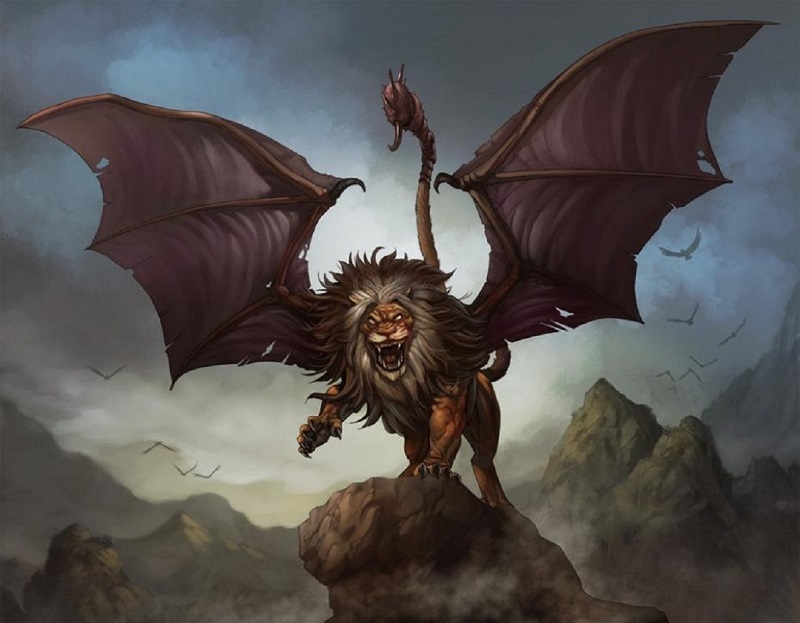
The word manticore itself is an adaption of the Persian name for the beast – martichoras. This is thought to loosely translate to ‘man eater.’ According to Persian lore, the creature was able to devour any beast (except elephants of course) without leaving any remains behind. However, despite its dominance in the jungle, the manticore had an especially intense hunger for human flesh. It was said to make due with one man if that was all that was available, but much rather preferred to lie in wait for a minimum of two to three men and devour them all. It was rumored that the manticore was able to kill three men at once without issue and could likely take more than that number if the opportunity presented itself.
The Manticore According to Legend
The manticore was seen as an apex predator that couldn’t be matched by man. The beast was supposedly known to have incredible speed that not even the fastest man could compete with in a chase. In addition to this, the body of a manticore was similar to a lion. This meant that the beast also had long, sharp claws that it could use to tear apart its victims if the opportunity arose. The beast was supposedly capable of ripping a man apart with one swipe of its mighty paws.
Though the claws of the beast were no doubt intimidating, many recorded tales suggest that the manticore rarely relied on them. The tail of the beast resembled that of a scorpion and had several large ‘stings’ that came off the sides and one sting that rested at the tip of the tail. These stings were poisonous and could be used to prick a victim if in close proximity. Distance, however, didn’t bring much more safety to a potential victim of the manticore. It was said that the mighty beast had the ability to shoot these stings from its tail like arrows. When one sting had been shot, it was replaced by another that could then be shot at the target until the beast was successful. These stings would inject the victim with poison and cause them to become paralyzed. The beast was then free to devour the victim without a struggle.
The manticore was famed for eating its victims whole and leaving nothing behind. While many other beasts of the forest are able to devour the entirety of the human body, the manticore took its feasting a step farther. In addition to eating all of its victims remains, it also ate their clothing, money, and other possessions. Because of this, there was often little evidence that the manticore had struck aside from trace amounts of blood. This is also part of the reason the beast was feared by so many. Whenever a person went missing and searches failed to return any trace of their body or possessions, the loss of the person was blamed on a manticore attack.
It was claimed that the manticore lured people in by laying in tall grass or reeds. This would hide its magnificent body and show only the head of what appeared to be a bearded man. Many victims were said to have ventured too close to the beast, only to be devoured by its three rows of sharp teeth. It was thought that those who ventured too close to the beast failed to notice several key signs. Most notable of these signs was said to be the sound of music. It was thought that the manticore was unable to speak in human languages but had a voice similar to that of a trumpet. Because of this, the sound of music was often seen as a warning that a manticore was nearby. Other signs included location (seeing the head of a man in tall grass) or the appearance of the man they thought they were approaching. It is often said that the head of a manticore looked like a bearded man with blue or grey eyes. It is safe to say that few who saw the color of the beast’s eyes lived to tell the story later.
Can a Manticore be Overpowered or Killed?
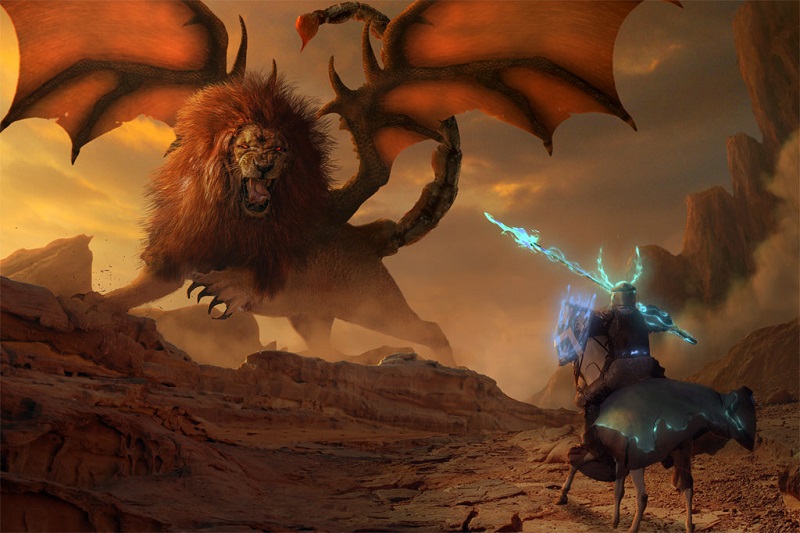
There were, however, measures that could be taken to ensure that these beasts were not able to grow into predators that were impossible to escape. Records show that it was believed a manticore could be hunted while it was young in order to prevent the development of one of its most fearsome attributes – its tail. Supposedly, skilled hunters were able to track down the young manticore cubs because their tails hadn’t yet developed the deadly stings. It was thought that if one could capture a manticore and stomp on the tail hard enough, the tail would become deformed and wouldn’t be able to grow the deadly stings that rendered villagers and travelers helpless against the beast.
Other than this, fighting the manticore was thought to be futile. It was believed that the fur of the manticore was impenetrable and any weapon used against the body of the beast would be in vain. Though no known records support the thought, some have hypothesized that the only place a manticore was vulnerable was in its mouth. However, even if a manticore were able to be killed with a fatal blow to the mouth, it is thought that the creature would simply resurrect as it is thought to have mythical powers.
The Manticore According to Ancient Greece
Though there is no evidence of a manticore to view in modern days, it is reported that the beast was captured on at least one occasion and presented to the then king of Persia as a gift. The manticore was given to King Artaxerxes II while Ctesias was serving in his court as a physician. It was through this exchange and the witnessing of the creature by Ctesias that the legend of the manticore was able to spread to the rest of the world – most notably Greece.
Once the legend of the manticore was spread to Greece, it was met with mixed reactions. A famed Greek author by the name of Pausanias wrote about the ‘martichoras’ with great skepticism in his book, ‘Description of Greece.’ It was his opinion that the great martichoras was nothing more than a tiger. He hypothesized that the additional details that spoke of the famed beast’s three rows of teeth and scorpion-like tail were nothing more than exaggerations that were used to express the extreme terror that was felt by anyone who had the misfortune of running into one of the beasts.
Pliny the Elder (another Greek writer who was famous for his work) did not share Pausanias’ opinion. He included the martichoras in his writing Naturalis Historia along with many animals that are known to exist today.
Physical Appearance
The manticore is often described as a mighty beast with fearsome features. The head of the beast is often said to be similar to that of a man. In most accounts, the head also has a beard and features eyes that are either blue or grey in color. From a distance, the head of a manticore isn’t a terrifying sight. It isn’t until the victim is close enough to the beast to see its open mouth and three rows of sharp teeth that the true nature of the beast becomes known.
There is also great emphasis given to the body of the beast. The body of the manticore is always described as being similar to that of a lion, but has a brilliant hue of red (often recorded as being scarlet in color). The manticore’s body is often much larger than that of a normal lion and is capable of performing impressive feats. The most notable of these feats is perhaps is surprisingly fast and agile speed. It is said that not even the fastest man can match the speed of a manticore when in pursuit of prey. Additionally, the claws of the beast are known to be extremely sharp. With one swipe of it’s mighty paw, a manticore can easily tear a man apart.
There are also some versions of the manticore that describe the beast as having a pair of mighty wings that allow it to fly in pursuit of its prey at terrifying speeds. These accounts normally describe wings that are similar to those of a dragon.
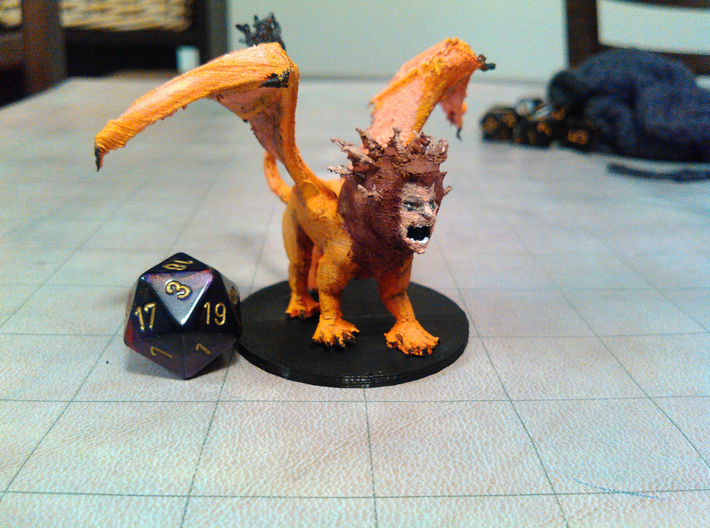
Last, but certainly not least is the fearsome tail of the mighty beast. The tail of the manticore is said to resemble that of a scorpion and has several stings that are poisonous to all creatures – except elephants. If the manticore is in close proximity to its prey, it can use these stings to stab its prey. It is important to note, however, that distance does not limit the use of this impressive feature. If a manticore is far away from its intended prey, it has the option of shooting these stings at its victim similar to the manner in which arrows are shot from a bow. Every sting that is fired from the tail of the creature is quickly replaced from another so that the manticore can continue its onslaught until it is successful and has rendered its prey defenseless.
It is also important to note that while the manticore has a human head, it is not able to speak human languages. Instead, it is said that the creature has the voice of a trumpet. This was considered to be one of the biggest warnings that the creature was on the hunt. Any sound of melody in the forest was considered to be the sign of a manticore.
Common Practices of the Manticore
The manticore is extremely cunning and is often noted for its impressive appetite. The beast is often said to use clever tactics to lure groups of people into its range so it can pounce on them and devour their entire being.
One of the most common tactics said to be employed by the manticore was to lay in tall grass so that only its human head was visible to anyone passing by. The seemingly harmless appearance of the head often lured people to come closer, allowing the manticore to strike and quickly devour them.
There are also many accounts of the creature that suggest it was greedy for human flesh. While the manticore would take any human prey it encountered, it was said to prefer to lay in wait for groups of people traveling together to satisfy its extreme hunger.
Possible Inspiration for the Manticore
Chimera
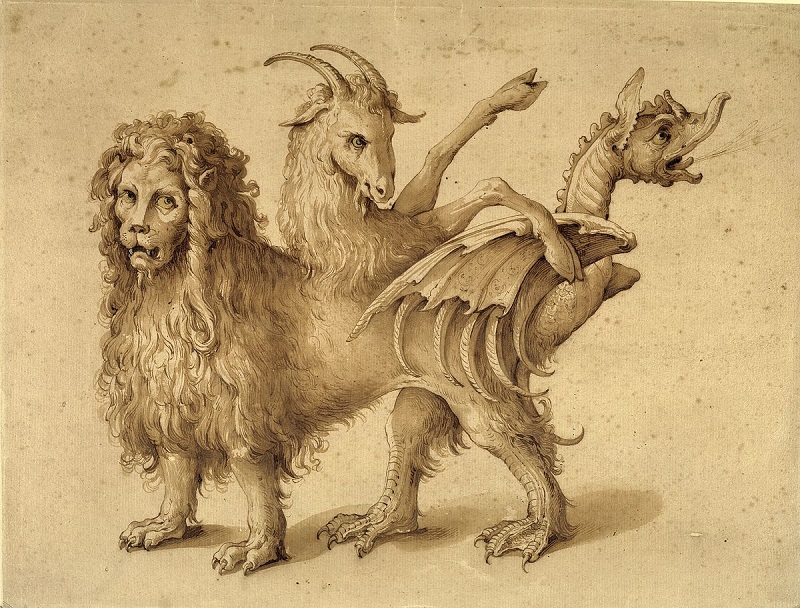
Chimera was one of the most feared monsters in Greek mythology and was thought to be the offspring of Typhon and Echidna. The beast was often described as being a lion with the head of a goat that rose from the back of the creature and a tail that ended with the head of a snake. However, there are variations of the beast that claim Chimera had a lion’s head and the body of a goat.
Chimera was known to bring disaster and was thought to be able to breathe fire. Any sighting of the creature was considered to be a bad omen.
Over time, the name ‘Chimera’ was used to describe any type of animal that had the features of at least two animals combined together.
Sphinx
The sphinx appears in both Egyptian and Greek mythology. The creature is often depicted as having a human head and a lion’s body. The sphinx also has the wings of an eagle and the tail of a serpent. The creature is considered to be female because its head often resembled that of a woman.
The sphinx was known for posing riddles to anyone it encountered. If a person struggled to answer the riddle or couldn’t answer correctly, the victim would be devoured by the sphinx. In Egyptian mythology, a sphinx was often used to guard sacred places to ensure that only those with a worthy heart were able to enter.
Explanation of the Myth
Many who study the story of the manticore are inclined to write the beast off as a tiger like Pausanias. It is thought that the story was used to describe the biggest and mightiest of the tigers that inhabited the jungles of India.
It is likely that the story also originated to explain the many missing persons who ventured into the jungle and never returned. It was likely easier to write off the disappearance of loved ones as being at the hands of an unconquerable beast instead of a vicious forest animal. These stories likely helped to save part of the population by preventing too many inexperienced travelers or hunters from going too far into the woods alone, as well as curbing the curiosity of young children.


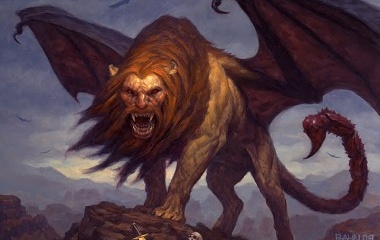
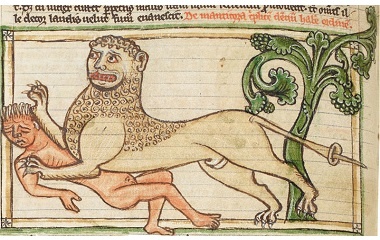
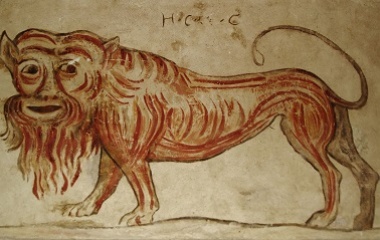






This help me to my school homework of english, THANK YOU SO MUCH!!!!!! love this website!!!!!
very informational, I LOVE THIS WEBSITE!!!!!!!
this helped with my school project thank you!